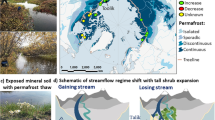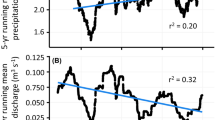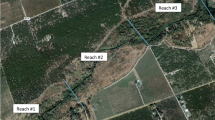Abstract
The water relations of riparian trees are often closely tied to stream hydrology and channel morphology, which can be altered by urban development. In regions with limited precipitation, urban water use can generate or augment dry-season stream flows, potentially providing a water subsidy to riparian trees. However, urbanization is also associated with high storm flows that cause stream channel incision, or downcutting, which could limit the effect of flow subsidies by lowering riparian water tables. We investigated the effects of urban dry-season flow subsidies and stream channel incision on the water status of streamside trees in Sacramento, California, which has a Mediterranean climate with a distinct and lengthy dry season. For two common facultative riparian species, Quercus lobata (valley oak) and Fraxinus latifolia (Oregon ash), we analyzed both midday stem water potential (Ψstem) measurements and leaf carbon isotope signatures (∂13C) to determine whether channel incision and dry-season flow had interacting effects on seasonal midday water stress and longer-term water use efficiency. We found that stream flow could substantially reduce dry-season water stress in both tree species, but only at low levels of channel incision. Leaf ∂13C signatures for Q. lobata suggested increased water use efficiency in trees growing along incised streams and those lacking dry-season flow. Urban management decisions that affect both dry-season base flows and channel incision can thus influence the growth and health of riparian trees, potentially leading to broader changes in riparian ecosystems.




Similar content being viewed by others
References
Abtew W, Melesse AM (2013) Evaporation and evapotranspiration: measurements and estimations. Springer Netherlands, Dordrecht
Bartoń K (2018) MuMIn: Multi-model inference
Bates D, Mächler M, Bolker B, Walker S (2015) Fitting linear mixed-effects models using lme4. J Stat Softw 67:1–48. https://doi.org/10.18637/jss.v067.i01
Bernhardt ES, Palmer MA (2007) Restoring streams in an urbanizing world. Freshw Biol 52:738–751. https://doi.org/10.1111/j.1365-2427.2006.01718.x
Booth DB (1990) Stream-channel incision following drainage-basin urbanization. Water Resour Bull 26:407–417. https://doi.org/10.1111/j.1752-1688.1990.tb01380.x
Broadmeadow MSJ, Griffiths H (1993) Carbon isotope discrimination and the coupling of CO2 fluxes within forest canopies. In: Ehleringer JR, Hall AE, Farquhar GD (eds) Stable isotopes and plant carbon-water relations. Academic Press, San Diego, CA
Brunner I, Herzog C, Dawes MA, Arend M, Sperisen C (2015) How tree roots respond to drought. Front Plant Sci 6:547. https://doi.org/10.3389/fpls.2015.00547
California DWR (Department of Water Resources) (2014) Water Data Library - Groundwater level reports. http://www.water.ca.gov/waterdatalibrary. Accessed 12 Mar 2014
Cernusak LA, Ubierna N, Winter K, Holtum JA, Marshall JD, Farquhar GD (2013) Environmental and physiological determinants of carbon isotope discrimination in terrestrial plants. New Phytol 200:950–965. https://doi.org/10.1111/nph.12423
Chaves MM, Osorio J, Pereira JS (2004) Water use efficiency and photosynthesis. In: bacon MA (ed) water use efficiency in plant biology. CRC press: Boca Raton, FL
Choat B, Jansen S, Brodribb TJ, Cochard H, Delzon S, Bhaskar R, Bucci SJ, Feild TS, Gleason SM, Hacke UG, Jacobsen AL, Lens F, Maherali H, Martínez-Vilalta J, Mayr S, Mencuccini M, Mitchell PJ, Nardini A, Pittermann J, Pratt RB, Sperry JS, Westoby M, Wright IJ, Zanne AE (2012) Global convergence in the vulnerability of forests to drought. Nature 491:752–755. https://doi.org/10.1038/nature11688
CIMIS (2018) California Irrigation Management Information System. https://cimis.water.ca.gov/Default.aspx. Accessed 25 Jun 2018
Criss RE, Davisson ML (1996) Isotopic imaging of surface water/groundwater interactions, Sacramento Valley, California. J Hydrol 178:205–222. https://doi.org/10.1016/0022-1694(96)83733-4
Crous CJ, Jacobs SM, Esler KJ (2012) Drought-tolerance of an invasive alien tree, Acacia mearnsii and two native competitors in fynbos riparian ecotones. Biol Invasions 14:619–631. https://doi.org/10.1007/s10530-011-0103-y
Dai A, National Center for Atmospheric Research Staff (2017) The Climate Data Guide: Palmer Drought Severity Index (PDSI). https://climatedataguide.ucar.edu/climate-data/palmer-drought-severity-index-pdsi.
Damesin C, Rambal S, Joffre R (1997) Between-tree variations in leaf δ13C of Quercus pubescens and Quercus ilex among Mediterranean habitats with different water availability. Oecologia 111:26–35. https://doi.org/10.1007/s004420050204
Damesin C, Rambal S, Joffre R (1998) Seasonal and annual changes in leaf δ13C in two co-occurring Mediterranean oaks: relations to leaf growth and drought progression. Funct Ecol 12:778–785. https://doi.org/10.1046/j.1365-2435.1998.00259.x
Dawson TE (1996) Determining water use by trees and forests from isotopic, energy balance and transpiration analyses: the roles of tree size and hydraulic lift. Tree Physiol 16:263–272. https://doi.org/10.1093/treephys/16.1-2.263
Dawson T, Ehleringer J (1991) Streamside trees that do not use stream water. Nature 350:335–337. https://doi.org/10.1038/350335a0
Duncan JM, Groffman PM, Band LE (2013) Towards closing the watershed nitrogen budget: spatial and temporal scaling of denitrification. J Geophys Res-Biogeosciences 118:1105–1119. https://doi.org/10.1002/jgrg.20090
Farquhar GD, O’Leary MH, Berry JA (1982) On the relationship between carbon isotope discrimination and the intercellular carbon dioxide concentration in leaves. Funct Plant Biol 9:121–137. https://doi.org/10.1071/pp9820121
Farquhar GD, Ehleringer JR, Hubick KT (1989) Carbon isotope discrimination and photosynthesis. Annu Rev Plant Physiol Plant Mol Biol 40:503–537. https://doi.org/10.1146/annurev.pp.40.060189.002443
Fox J, Weisberg S (2018) Visualizing fit and lack of fit in complex regression models with predictor effect plots and partial residuals. J Stat Softw 87:1–27. https://doi.org/10.18637/jss.v087.i09
Gatica MG, Aranibar JN, Pucheta E (2017) Environmental and species-specific controls on δ13C and δ15N in dominant woody plants from central-western Argentinian drylands. Austral Ecol 42:533–543. https://doi.org/10.1111/aec.12473
Gerdol R, Iacumin P, Tonin R (2018) Bedrock geology affects foliar nutrient status but has minor influence on leaf carbon isotope discrimination across altitudinal gradients. PLoS One 13:e0202810. https://doi.org/10.1371/journal.pone.0202810
Griffin JR (1973) Xylem sap tension in three woodland oaks of Central California. Ecology 54:152–159. https://doi.org/10.2307/1934384
Groffman PM, Boulware NJ, Zipperer WC et al (2002) Soil nitrogen cycle processes in urban riparian zones. Environ Sci Technol 36:4547–4552. https://doi.org/10.1021/es020649z
Hoch G, Richter A, Körner C (2003) Non-structural carbon compounds in temperate forest trees. Plant Cell Environ 26:1067–1081. https://doi.org/10.1046/j.0016-8025.2003.01032.x
Hoffmann WA, Franco AC, Moreira MZ, Haridasan M (2005) Specific leaf area explains differences in leaf traits between congeneric savanna and forest trees. Funct Ecol 19:932–940. https://doi.org/10.1111/j.1365-2435.2005.01045.x
Holstein G (1984) California riparian forests: deciduous islands in an evergreen sea. In: Warner RE, Hendrix KM (eds) California riparian systems: ecology, conservation, and productive management. University of California Press, pp 2–23
Howard JL (1992) Quercus lobata. In: U.S. Department of Agriculture, Forest Service, Rocky Mountain Research Station, fire sciences laboratory (ed) fire effects information system. https://www.fs.fed.us/database/feis/plants/tree/quelob/all.html. Accessed 23 Nov 2017
Katibah EF (1984) A brief history of riparian forests in the Central Valley of California. In: Warner RE, Hendrix KM (eds) California riparian systems: ecology, conservation, and productive management. University of California Press, Berkeley, California, pp 23–29
Klein T (2014) The variability of stomatal sensitivity to leaf water potential across tree species indicates a continuum between isohydric and anisohydric behaviours. Funct Ecol 28:1313–1320. https://doi.org/10.1111/1365-2435.12289
Knops JM, Koenig WD (1994) Water use strategies of five sympatric species of Quercus in central coastal California. Madroño 41:290–301
Knops JMH, Koenig WD (2000) Annual variation in xylem water potential in California oaks. Madroño 47:106–108
Kogami H, Hanba YT, Kibe T et al (2001) CO2 transfer conductance, leaf structure and carbon isotope composition of Polygonum cuspidatum leaves from low and high altitudes. Plant Cell Environ 24:529–538. https://doi.org/10.1046/j.1365-3040.2001.00696.x
Kuznetsova A, Brockhoff PB, Christensen RHB (2017) lmerTest package: tests in linear mixed effects models. J stat Softw 82. https://doi.org/10.18637/jss.v082.i13
Lewis DC, Burgy RH (1964) The relationship between oak tree roots and groundwater in fractured rock as determined by tritium tracing. J Geophys Res 69:2579–2588. https://doi.org/10.1029/JZ069i012p02579
Loheide SP, Gorelick SM (2007) Riparian hydroecology: a coupled model of the observed interactions between groundwater flow and meadow vegetation patterning. Water Resour Res 43:W07414. https://doi.org/10.1029/2006WR005233
McCutchan H, Shackel KA (1992) Stem-water potential as a sensitive indicator of water stress in prune trees (Prunus domestica L. cv. French). J Am Soc Hortic Sci 117:607–611
McDowell NG, Bond BJ, Dickman LT et al (2011) Relationships between tree height and carbon isotope discrimination. In: Dawson TE, Lachenbruch B (eds) Meinzer FC. Springer, Size-and age-related changes in tree structure and function, pp 255–286
Naiman RJ, Bechtold JS, Drake DC et al (2005) Origins, patterns, and importance of heterogeneity in riparian systems. In: Lovett GM, Turner MG, Jones CG, Weathers KC (eds) Ecosystem function in heterogeneous landscapes. Springer, New York, NY, pp 279–309
Naor A (2000) Midday stem water potential as a plant water stress indicator for irrigation scheduling in fruit trees. Acta Hortic 537:447–454. https://doi.org/10.17660/ActaHortic.2000.537.52
Onoda Y, Wright IJ, Evans JR, Hikosaka K, Kitajima K, Niinemets Ü, Poorter H, Tosens T, Westoby M (2017) Physiological and structural tradeoffs underlying the leaf economics spectrum. New Phytol 214:1447–1463. https://doi.org/10.1146/annurev.ecolsys.32.081501.11404010.1111/nph.14496
Owston PW (1990) Fraxinus latifolia Benth. In: Burns RM, Honkala BH (eds) Silvics of North America. U.S. Department of Agriculture, Forest Service, agriculture handbook 654
Paul MJ, Meyer JL (2001) Streams in the urban landscape. Annu Rev Ecol Syst 32:333–365. https://doi.org/10.1146/annurev.ecolsys.32.081501.114040
R Core Team (2018) R: a language and environment for statistical computing. R Foundation for Statistical Computing, Vienna, Austria
Sacramento Groundwater Authority (2016) Basin management report. Sacramento, California
Shackel K, Gross R (2002) Using midday stem water potential to assess irrigation needs of landscape valley oaks. In: Standiford RB, et al (eds) Proceedings of the fifth symposium on oak woodlands: oaks in California's challenging landscape. Gen. Tech. Rep. PSW-GTR-184, Albany, CA: Pacific Southwest Research Station, Forest Service, U.S. Department of Agriculture: 397–402
Shackel KA, Ahmadi H, Biasi W et al (1997) Plant water status as an index of irrigation need in deciduous fruit trees. HortTechnology 7:23–29. https://doi.org/10.21273/HORTTECH.7.1.23
Shackel K, Lampinen B, Sibbett S, Olson W (2000) The relation of midday stem water potential to the growth and physiology of fruit trees under water limited conditions. Acta Hortic:425–430. https://doi.org/10.17660/ActaHortic.2000.537.50
Soil Survey Staff (2018) Soil survey geographic (SSURGO) database. U.S. Department of Agriculture, Natural Resources Conservation Service
Solins JP, Cadenasso ML (2019) Testing urban drivers of riparian woody vegetation composition in a precipitation-limited system. J Ecol. https://doi.org/10.1111/1365-2745.13300
Solins JP, Thorne JH, Cadenasso ML (2018) Riparian canopy expansion in an urban landscape: multiple drivers of vegetation change along headwater streams near Sacramento, California. Landsc Urban Plan 172:37–46. https://doi.org/10.1016/j.landurbplan.2017.12.005
Sparks JP, Ehleringer JR (1997) Leaf carbon isotope discrimination and nitrogen content for riparian trees along elevational transects. Oecologia 109:362–367. https://doi.org/10.1007/s004420050094
Stewart GR, Turnbull MH, Schmidt S, Erskine PD (1995) 13C natural abundance in plant communities along a rainfall gradient: a biological integrator of water availability. Funct Plant Biol 22:51–55. https://doi.org/10.1071/pp9950051
Strahler AN (1957) Quantitative analysis of watershed geomorphology. EOS Trans Am Geophys Union 38:913–920. https://doi.org/10.1029/TR038i006p00913
Stromberg JC (2001) Influence of stream flow regime and temperature on growth rate of the riparian tree, Platanus wrightii, in Arizona. Freshw Biol 46:227–239. https://doi.org/10.1046/j.1365-2427.2001.00651.x
Stromberg JC, Patten DT (1990) Riparian vegetation instream flow requirements: a case study from a diverted stream in the eastern Sierra Nevada, California, USA. Environ Manag 14:185–194. https://doi.org/10.1007/BF02394035
Sun X, Kang H, Chen HY et al (2016) Phenotypic plasticity controls regional-scale variation in Quercus variabilis leaf δ13C. Trees Heidelb 30:1445–1453. https://doi.org/10.1007/s00468-016-1380-y
Swift CC, Jacobs SM, Esler KJ (2008) Drought induced xylem embolism in four riparian trees from the Western Cape Province: insights and implications for planning and evaluation of restoration. South Afr J Bot 74:508–516. https://doi.org/10.1016/j.sajb.2008.01.169
Vitousek PM, Field CB, Matson PA (1990) Variation in foliar δ13C in Hawaiian Metrosideros polymorpha: a case of internal resistance? Oecologia 84:362–370. https://doi.org/10.1007/BF00329760
Walsh CJ, Roy AH, Feminella JW, et al (2005) The urban stream syndrome: current knowledge and the search for a cure. J North Am Benthol Soc 24:706–723. https://doi.org/10.1899/04-028.1(2005)0242.0.CO;2
Weih M, Bonosi L, Ghelardini L, Rönnberg-Wästljung AC (2011) Optimizing nitrogen economy under drought: increased leaf nitrogen is an acclimation to water stress in willow (Salix spp.). Ann Bot 108:1347–1353. https://doi.org/10.1093/aob/mcr227
White MD, Greer KA (2006) The effects of watershed urbanization on the stream hydrology and riparian vegetation of los Peñasquitos Creek, California. Landsc Urban Plan 74:125–138. https://doi.org/10.1016/j.landurbplan.2004.11.015
WRCC (2016) Western Regional Climate Center: Sacramento climate summary. http://www.wrcc.dri.edu/cgi-bin/cliMAIN.pl?ca7630. Accessed 4 Jul 2016
Acknowledgements
The authors thank Matthew Gilbert and Kenneth Shackel for providing logistical and conceptual assistance with this project, as well as Valerie Eviner, Emilio Laca, and members of the Cadenasso Lab for comments on earlier drafts. We also appreciate field and lab help from Dennise Alatorre, Jennifer Boyer, Seth and Lilah Castleman, Joe Fiorello, Grant Halstrom, Amber Kimpel, Kristina Louie, Indya Messier, Bryn Montgomery, Jessica Rudnick, Taran Sahota, Heather Smith, Nikita Sinha, Alex Webster, and Felicia Wong. JPS was partially supported by a Garden Club of America Zone VI Fellowship in Urban Forestry, with additional funding from the Jastro Shields Graduate Research Scholarship. MLC was partially supported by the USDA National Institute of Food and Agriculture, Hatch project 1013395.
Author information
Authors and Affiliations
Corresponding author
Rights and permissions
About this article
Cite this article
Solins, J.P., Cadenasso, M.L. Urban channel incision and stream flow subsidies have contrasting effects on the water status of riparian trees. Urban Ecosyst 23, 419–430 (2020). https://doi.org/10.1007/s11252-020-00926-2
Published:
Issue Date:
DOI: https://doi.org/10.1007/s11252-020-00926-2




